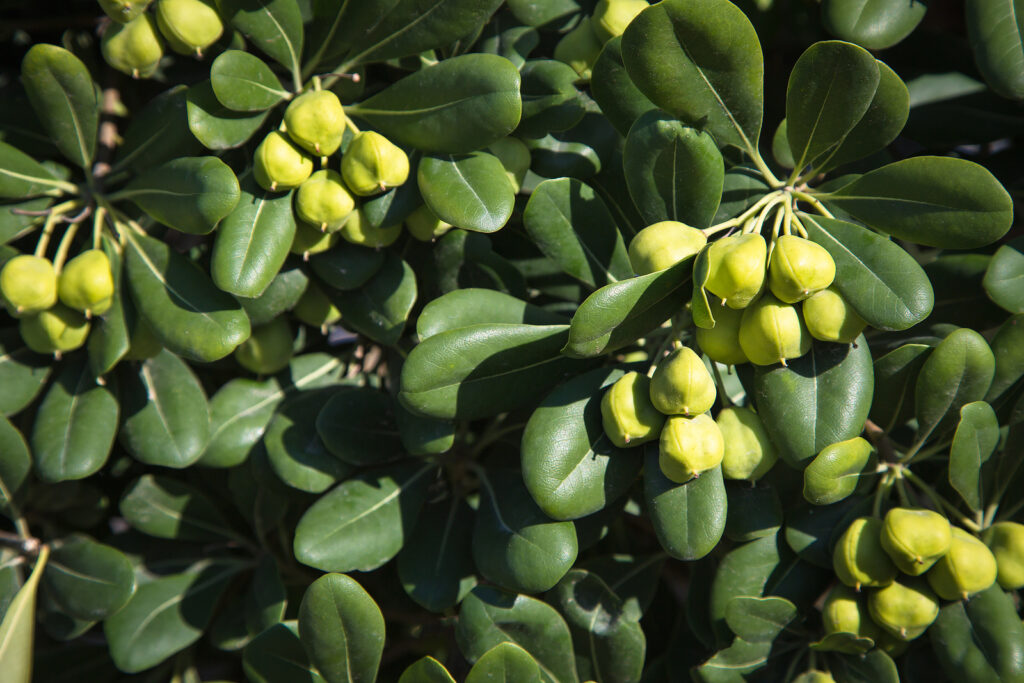Pittosporum is a genus of subtropical mostly evergreen shrubs and trees grown for their glossy, leathery leaves and dense foliage. Pittosporums also bear clusters of fragrant small white flowers and showy pea-size fruit.
Pittosporums adapt to a wide range of soils and tend to make good seaside plantings. They can withstand salt, drought, and wind, in full sun or partial shade.
Pittosporums are often grown as foundation plants, hedges, screens, and windbreaks. Some make good clipped hedges; all have pleasing outlines when left unclipped. In warmer climates, trees are good specimens.
Pittosporum is a genus of about 200 species, most are evergreen shrubs and trees. Pittosporums are native from sandy savannahs to rainforests most in Australasia.

Get to know Pittosporum
- Plant type: Evergreen shrubs and trees
- Growing zones and range: Zones 9 to 11
- Hardiness: Hardy to 32℉ (0℃)
- Height and width: 15 to 30 feet (5-10m) tall and 6 to 15 feet (2-5m) wide; some dwarf varieties
- Foliage: Glossy, often leathery leaves borne alternately or in whorls
- Flowers: Often fragrant, 5-petaled flowers in terminal corymbs, umbels, panicles, or clusters
- Bloom time: Summer
- Fruit: Nearly spherical, woody fruits (capsules) that contain black seds in a sticky yellow mucilage. Ripe fruits (usually orange) split open to reveal sticky seeds; fallen fruit can be a nuisance on lawns or paving.
- Uses: Good clipped hedges; dependable shrubs
- Common name: Pittosporum, kohuhu
- Botanical name: Pittosporum
- Family name: Pittosporaceae
- Origin: Australasia, South and East Asia, and Africa.
Where to plant Pittosporum
- Grow Pittosporum in full sun or partial shade.
- Pittosproun will grow in a range of soils. Pittosporun grows best in humus-rich, well-drained soil.
- Pittosporum make good seaside plantings. Piitosporum can withstand salt, drought, and wind.
- Where Pittosporum is not hardy it should be sheltered from cold and drying winds.
When to plant Pittosporum
- Set container-grown Pittopsorum in the garden in spring or autumn.
Planting and spacing Pittosporum
- Space Pittopsoorum 6 to 15 feet (2-5m) apart depending on how you want to let plants mature. Plant 6 feet apart if growing as a hedge.
How to water and feed Pittosporum
- Water Pittopsorum moderately during the growing season. Water sparingly during winter.
- Fertilize Pittosporun with a balanced liquid fertilizer monthly.

Pittosporum care
- Trim Pittosporum hedges in spring and midsummer.
Growing Pittosporum as a houseplant
- Pittosporum grows best in bright light, a cool temperature, and low to medium humidity; it can tolerate a warm temperature if the humidity is increased.
- The soil should be kept relatively dry.
- Fertilize Pittosporum once in spring and once in summer.
- Rinse the foliage of indoor plants regularly to keep them clean and glossy.
Pittosporum pests and diseases
- Pittosporum is prone to attack by aphids, spider mites, mealybugs, and scale insects.
- Pittosporum can summer leaf spot, dieback, root know nematodes, galls, and cankers,
Pittosporum propagation
- Sow Pittosporum seed as soon as ripe or in sproing in containers in a cold frame.
- Take semi-ripe cuttings in summer.
- Layer or air layer Pittosproum in spring.
Pittosporum varieties to grow
- Pittosporum crassifolium. Can grow to 25 feet tall in 8 to 10 years; yearly pruning can keep it at 6 to 10 feet tall and 6 to 8 feet wide. Gray-green, 1 to 2-inches-long leaves with rounded ends on densely set on branches; maroon flowers appear in late spring. Tolerates seaside conditions. ‘Compactum’ is a 3-foot dwarf.
- P. eugenioides. Often grown as a high hedge or screen plant; can grow to 40 feet tall and 20 feet wide, with curving gray trunk, if left unpruned. Wavy-edged, lance-shaped, 2 to 4-innc leaves are yellowish to deep green. Fragrant yellow spring flowers. A form with leaves edged in creamy white is grows to 10 feet tall.
- P. phillyraeoides. Willow pittosporum. Slow growing shrub to 20 feet tall and 15 feet wide. Weeping habit, with trailing branches and very narrow, 3-inxh-long leaves. Small, fragrant, bell-shaped yellow flowers from late winter to early spring; flowers are followed by deep yellow fruit. Best grown as a specimen tree. More tolerant of heat, drought than other species.
- P. tenuifolium (P. nigricans). Superficially similar to P. eugenioides but shorter; has darker twigs and leafstalks; more oval, less wavy-edged, deeper green leaves; purple flowers. Good tolerance of seaside conditions. Selections available with dark purple or variegated leaves. Cultivar ‘Irene Paterson’ grows slowly to about 8 feet tall and 4 feet wide.
- P. tobira. Tobira. Dense, rounded shrub, grow slowly from 10 to 15 feet tall if not pruned. Lower limbs can be removed from older plants to make small trees. Whorls of leathery, narrowly elliptical, shiny dark green leaves to 5 inches long; creamy white flowers are borne at branch tips in early spring, smell like orange blossoms. Very tolerant of seaside conditions. Cultivars include: ‘Wheeler’s Dwarf’ grows to 2 feet high; ‘Variegata’ grows to 5 to10 feet tall, has gray-green leaves edged white; ‘Turner’s Dwarf’ is a low plant with same foliage color as ‘Variegata’.
- P. undulatum. Victorian box. Moderately fast grower to 15 feet, then grows slow to 30-40 feet tall and wide. Glossy green, lance-shaped, wavy-edged leaves to 6 inches long. Very fragrant creamy white flowers in early spring. Grow as a screen by planting 5 to 8 feet apart; best to prune not shear for dense growth. Strong roots become invasive with age.















